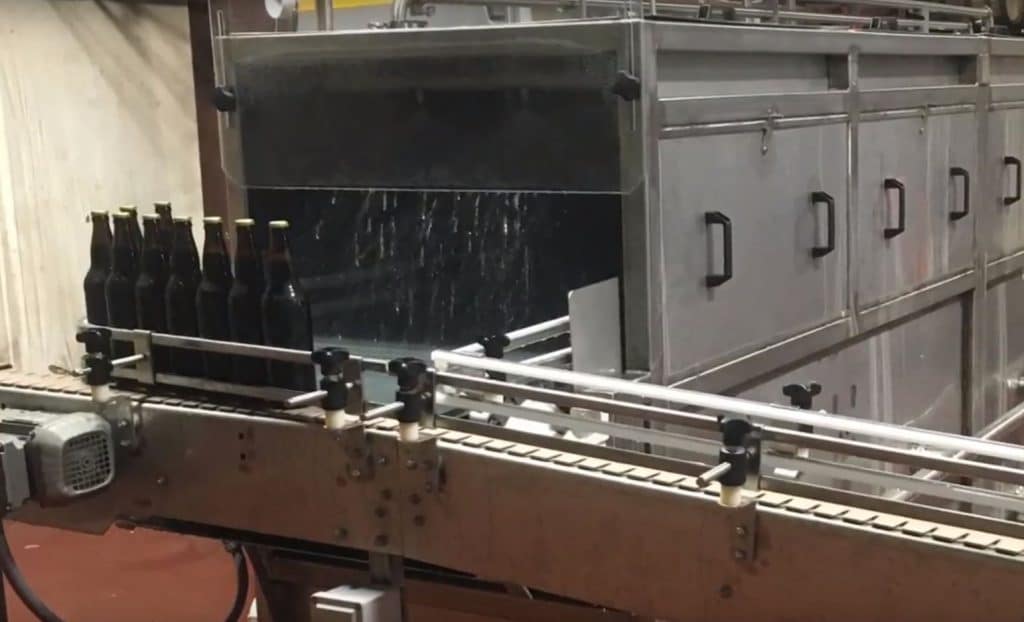 Tunnel pasteurizers and flash pasteurization are effective methods for pasteurizing liquids. The difference between these two pasteurization methods is that flash pasteurization pasteurizes the product, not the package. During tunnel pasteurization, both the package and the product get pasteurized.
Tunnel pasteurizers and flash pasteurization are effective methods for pasteurizing liquids. The difference between these two pasteurization methods is that flash pasteurization pasteurizes the product, not the package. During tunnel pasteurization, both the package and the product get pasteurized.
Many factors can impact your decision to pick one process or the other, but the best pasteurization method will depend on your product, manufacturing operation, needs, and goals.
Why Should You Pasteurize Your Beer?
Beer doesn’t have to be pasteurized to be safe for consumption. However, for commercial breweries that sell their products in stores and across the country, a great deal of time can pass between the time a beer is bottled and the moment it touches a customer’s lips.
Pasteurization can help extend the shelf life of your product, so the beer your customers drink meets the taste and quality you want them to experience.
It’s important to factor in shipping, warehouse time, sitting on the shelf, and even time it may sit in a customer’s refrigerator.
Here are several other reasons why commercial brewers pasteurize their beer:
- The process destroys most pathogens and microorganisms and ensures that they’re not in the packaged beer that could cause it to go bad
- The pasteurization process halts the growth of any yeast that may be leftover in the beer
- It preserves the freshness of the beer
- Increases the shelf life of your beer
- Reduces the need for refrigeration
- A pasteurized bottle or can of beer can be stored at room temperature for more than 120 days
- Unpasteurized draft beer in a keg has a lifespan of 45 to 60 days. Pasteurized draft beer can last six to nine months, which is beneficial for extended shipping.
- Pasteurized beer in a keg, once opened, can be re-refrigerated. It can be brought back out at a later date for serving. Unpasteurized beer can’t.
- Commercial brewers can ship their products farther away and expand their market reach
Which Beers Are Pasteurized?
In the United States,
- Domestic beer in cans and bottles are typically pasteurized
- Imported draft beer in kegs are pasteurized. Kegs may remain at room temperature without affecting the taste of the beer in any negative way
- Domestic draft beer in kegs is often not pasteurized. To halt secondary fermentation, the beer has to remain refrigerated at 38 degrees Fahrenheit
What Are The Main Ways To Pasteurize Beer?
Flash Pasteurization
With flash pasteurization, the beer undergoes a special process called the thermal bypass system. In this process, as the beer flows from the filter to the bright tank, it’s heated in a pipe.
In the pipe, there’s actually a pipe within a pipe. The beer flows one way in one pipe, and heated water or steam flows the other way in the other pipe.
As they pass each other, the beer’s temperature goes up. It then runs through a heat exchanger and is cooled. This process takes about 20 to 30 seconds.
This type of pasteurization is used mainly for keg beer.
For American lagers, the beer is poured into the keg, and then the temperature is raised rapidly and evenly to 160 degrees Fahrenheit, or 71 degrees Celsius, for 20 seconds.
For European ales and lagers, the temperature is raised rapidly and evenly to 161.6 degrees Fahrenheit, or 72 degrees Celsius, for 30 seconds.
Types of Flash Pasteurization Used With Beer
Steady State
With the steady state process, the temperature, flow, and pressure must remain constant throughout the pasteurization process. Pasteurized, heated water is sent through the system over and over in a constantly controlled state. The heat from the water pasteurizes the beer.
Variable
With the variable process, the temperature, pressure, and flow are varied through the process. It’s done in this way to keep a controlled beer level within a sterilized beer tank. At the end of the process, the beer ends up pasteurized.
Problems with Flash Pasteurization
The downside of flash pasteurization is that the beer can be exposed to unwanted microbes during the packaging process. The downstream equipment must be absolutely sanitary.
Tunnel pasteurization avoids that problem: the beer is already sealed in its final package before heating begins, so there is less chance of contamination.
Tunnel Pasteurization
Tunnel pasteurization is the process of taking liquid-filled cans or bottles and running them through a stainless steel tunnel where hot water is sprayed onto the finished product.
Professional brewers have discovered that this process is an ideal way to pasteurize beer being made for mass consumption. It’s also being used by more and more mid-tier craft breweries that are shipping their products regionally or nationally.
Large tunnel pasteurizers, commonly used by commercial brewing facilities, heat the beer until the liquid at the center of the bottle or can reaches 140F. The beer is held at this temperature for a predetermined amount of time before moving into the cooling section of the tunnel.
With tunnel pasteurization, the beer is poured into bottles and cans, and then the bottles or cans are moved into an enclosed conveyor. Once in the conveyor, they’re sprayed with, or immersed in, hot water or steam to 165 degrees Fahrenheit, or 74 degrees Celsius. After the heat bath, the bottles or cans are then sprayed with cold water to cool them down.
Tunnel pasteurization isn’t typically used with kegs because of their size. Their size and amount of beer causes the process to take too long to heat and cool.
Tunnel pasteurization has several benefits:
- Extremely effective at inhibiting pathogens and microorganisms
- Effective at halting the growth of yeast, thus curtailing secondary fermentation
- Useful for commercial craft brewers who bottle or can their product and ship regionally or nationally
- Not work-intensive, unlike flash pasteurization that demands different processes and stages depending upon the type of beer
Alternatives to Beer Pasteurization
The alternatives to pasteurizing beer are to sterile filter it or run a perfectly sanitary packaging line. Sterile filtration also affects beer flavor by stripping out some proteins and hop bitterness.
This procedure has the same drawback as flash pasteurizing: the downstream packaging equipment must be sanitary.
It is not that easy to keep bottling and canning lines close to sterile. They are very complicated machines with thousands of parts and myriad opportunities for microbial contamination.
What Keeps Beer Safe for People?
No human pathogens can survive in beer; the lack of oxygen and high acidity are too different from our innards. There are organisms that can live in beer, though.
The most common consequence of microbiologically tainted beer is a buttery character caused by a bacteria called pediococcus. Beers can also turn sour because of bacteria that produce lactic acid. While the beer isn’t harmful, it’s not very tasty.
Other organisms can cause the beer to become over-carbonated and gush upon opening. Wild yeasts can cause gushing, and will also add a phenolic character to the beer best described as “medicinal” or “plastic-like.”
Learn More About Beer Pasteurization
We’ve been designing, building, and installing tunnel pasteurizers for commercial breweries for decades. Our past projects have ranged from large national brewing operations to small craft breweries, so there’s very little we haven’t encountered over the years.
The dimensions depend on your project, and we’re here to help. Learn more about tunnel pasteurizers for beer pasteurization to get started today.
Learn More About Tunnel Pasteurizers From Smart Machine Technologies





 Contract
Contract Food & Bev
Food & Bev